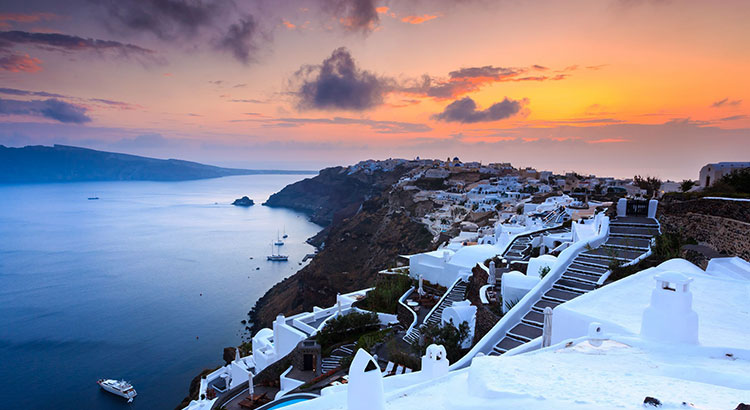Caldera
Santorini caldera is a large, mostly submerged caldera, located in the southern Aegean Sea, 120 kilometers north of Crete in Greece. Visible above water is the circular Santorini island group, consisting of Santorini (aka Thera), the main island, Therasia and Aspronisi at the periphery, and the Kameni islands at the center.
The caldera measures about 12 by 7 km (7.5 by 4.3 mi), with 300 m (980 ft) high steep cliffs on three sides.
There are two small volcanic islands at the center of the caldera, Nea ("New") Kameni and Palea ("Old") Kameni.
The main island, Santorini has an area of 75.8 km2 (29.3 sq mi) km2, Therasia 9.3 km2 (3.6 sq mi), and the uninhabited islands of Nea Kameni 3.4 km2 (1.3 sq mi), Palea Kameni 0.5 km2 (0.19 sq mi) and Aspronisi 0.1 km2 (0.039 sq mi).
The extraordinary beauty of Santorini's high walls, draped by whitewashed villages, combined with a sunny climate and perfect observation conditions, have made it a magnet for volcanologists, as well as a highlight of tourism in the Aegean.
The volcanic complex of Santorini is the most active part of the South Aegean Volcanic Arc, which includes the volcanoes of Methana, Milos, Santorini and Nisyros. It marks the subduction of the African tectonic plate underneath the Aegean subplate of the Eurasian tectonic plate, at a rate of up to 5 cm per year in a northeasterly direction. It is characterized by earthquakes at depths of 150–170 km.
Non-volcanic rocks are exposed on Santorini at Mikro Profititis Ilias, Mesa Vouno, the Gavrillos ridge, Pirgos, Monolithos and the inner side of the caldera wall between Cape Plaka and Athinios.
The Kameni islands at the center of the caldera are made of lava rocks.
























